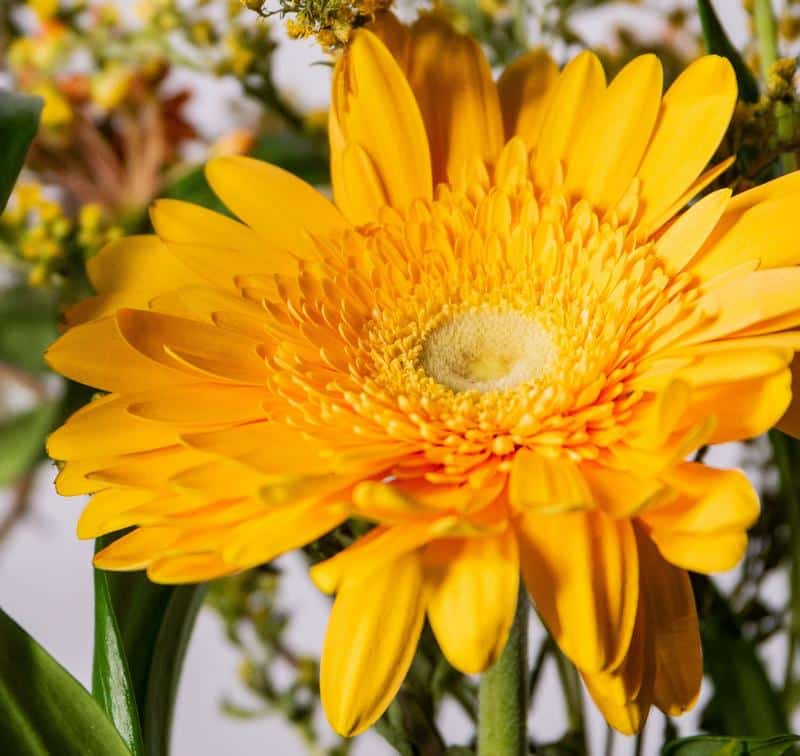Are Gerbera Daisies Toxic to Dogs? Are Gerbera Daisies Poisonous to Dogs?
Are gerbera daisies toxic to dogs? Are gerbera daisies poisonous to dogs? In this article, we’ll answer both of these similar questions and also things like can dogs eat gerbera daisies and what to do if they’ve already done so. We’re then going to teach you the two easy commands that will ensure your dog stays away from your gerberas from now on.
Next, we’ll help you learn about gerbera daisies, explaining what they look like, how to grow them, and how to keep them blooming. Finally, we’ll wrap everything up by instructing you on how to protect gerbera daisies from dogs so you can grow and garden without worry! Keep reading!
Are Gerbera Daisies Poisonous to Dogs?

Gerbera Daisies are not poisonous to dogs. If your dog eats a Gerbera Daisy, they are unlikely to experience any severe symptoms or side effects. However, any plant material can cause minor gastrointestinal upset in some dogs, such as vomiting or diarrhea.
Are Gerbera Daisies Toxic to Dogs?
Gerbera Daisies are not toxic to dogs. However, this does not mean that they are completely safe for your dog to eat. Any non-food item can pose a choking hazard or cause a blockage in your dog’s digestive tract, especially if your dog is small or tends to gulp down food or foreign objects.
Gerbera Daisy Poisoning in Dogs
Although Gerbera Daisies are not poisonous to dogs, ingestion can sometimes lead to mild gastrointestinal upset. Signs can include vomiting, diarrhea, or loss of appetite. If your dog shows any of these symptoms after consuming a Gerbera Daisy (also known as African Daisy), it’s always a good idea to contact your vet just to be on the safe side. However, severe reactions are unlikely.
Training the “Leave It” Command
Training your dog to understand the “Leave It” command can help keep them safe, especially when they show interest in potentially harmful items. Here’s an expanded way to train this command:
- Hold a treat in both hands.
- Show one hand with the treat to your dog, saying “Leave it.”
- When your dog diverts their attention away from that hand, reward them with the treat from the other hand.
- Repeat this process until your dog quickly shifts their attention away from the “leave it” treat.
- Progress to the next level by placing the treat on the floor, covering it with your hand. Say “Leave it,” and when your dog pulls back, reward them with a different treat.
- Gradually increase the difficulty, eventually practicing with real-life scenarios, using different items, and in various environments to ensure your dog fully grasps the command.
Training the “Drop It” Command
Like “Leave It,” the “Drop It” command is an essential safety command every dog should learn. It instructs your dog to release something they have in their mouth. Here’s a more in-depth way to train this command:
- Engage your dog in a game of tug using a toy they like.
- During the game, say “Drop it” in a calm but firm voice. Remember to avoid turning it into a shouting match as it can create a negative association for the dog.
- Once your dog releases the toy, provide a treat or praise. This positive reinforcement helps your dog understand that “Drop it” is a positive action.
- Repeat this process until your dog consistently drops the toy upon command.
- Practice “Drop It” in various situations and with different items to ensure your dog can apply the command in different contexts.
While Gerbera daisies are not poisonous to dogs, it’s always a good idea to discourage them from eating any kind of plant. Training essential commands like “Leave It” and “Drop It” can go a long way in preventing the potential ingestion of harmful substances.
It’s important to remember, though, that the underlying behavioral issues (curiosity, anxiety, boredom, etc.) that were causing all of this to begin with will still be present. And until you address those, any positive changes you see are only going to be temporary.
“Well, how do I make these changes last?”
By getting your dog to truly choose to follow your direction, that’s how. I tried many times to write out how you can do that before deciding it made more sense to just link you to the free video series that explains it better than I’d ever be able to.
The series is by a man named Dan who is one of the world’s leading dog obedience trainers. In it, he teaches you how to put an end to things like your dog eating Gerbera Daisies and all other misbehavior using his fast and easy-to-follow methods.
In the first video, Dan will reveal to you why the two most common methods of dog training only doom you to failure. You can watch the video now by clicking here. Follow the proven system he’ll show you in his series and you’ll never have to spend another second worrying about your dog eating a Gerbera Daisy ever again!
Can Dogs Eat Gerbera Daisies?

Dogs can eat Gerbera Daisies, but they still should not. While Gerbera Daisies are not toxic to dogs, eating too many of them could cause mild stomach upset. It’s always best to discourage dogs from eating any non-food items to avoid potential health issues.
Dogs Eating Gerbera Daisies, What Do I Do?
If your dog eats a Gerbera Daisy, don’t panic. These plants are not poisonous to dogs. However, depending on the amount consumed and your dog’s individual sensitivity, they might experience mild gastrointestinal upset like vomiting or diarrhea. Keep an eye on your dog for any unusual behavior and consult with your vet if any concerning symptoms arise.
Why Do Dogs Eat Gerbera Daisies?
Dogs eat Gerbera Daisies and other plants for a variety of reasons. They could be bored, hungry, or simply curious. Some dogs enjoy the texture or taste of plants. Others might eat non-food items due to a condition called pica, which could be indicative of nutritional deficiencies or other health issues.
If your dog eats Gerbera Daisies or other non-food items persistently, it would be a good idea to discuss this behavior with your vet.
Stopping Dogs Eating Gerbera Daisies
One of the best ways to stop your dog eating Gerbera Daisies is to supervise them when they are in an area where these flowers are present. If that’s not possible, consider creating a barrier around your flower beds or removing the plants entirely.
Training your dog to respond to commands like “leave it” or “drop it” can also be very effective. Learn both in the first section.
Encouraging Healthy Eating Habits in Dogs
Promote healthy eating habits in your dog by providing a balanced diet, regular meal times, and avoiding feeding them human food or table scraps. Offering mentally stimulating toys and sufficient exercise can also discourage them from eating non-food items out of boredom.
While Gerbera Daisies are not toxic to dogs, they aren’t food and shouldn’t be part of your pet’s diet. Encourage good eating habits and behaviors to ensure your dog stays healthy and safe. If you notice your dog frequently eating non-food items, it’s always a good idea to consult with a vet.
You should get this problem taken care of now as it will also keep your dog safe in the future around other plants. That will mean no worrying about things like are daisies toxic to dogs, are sunflowers toxic to dogs, are dandelions toxic to dogs, or are Shasta daisies poisonous to dogs.
What Are Gerbera Daisies?

Gerbera Daisies are bright, colorful flowering plants native to South Africa. Known for their vibrant colors and large, attractive blooms, they are popular in gardens and as cut flowers in floral arrangements. They’re not harmful to dogs, though ingestion can cause mild gastrointestinal upset in some cases.
What Do Gerbera Daisies Look Like?
Gerbera Daisies are characterized by their large, eye-catching flower heads, reminiscent of sunflowers. They have a central disc, composed of hundreds of individual tiny flowers, surrounded by large, overlapping petals. The petals come in various bright colors including pink, orange, yellow, and white. The plant’s leaves are long and slender, forming a rosette at the base of the stem.
How to Grow Gerbera Daisies
Growing Gerbera Daisies requires plenty of sunlight, well-drained soil, and regular watering. They thrive in full sun but can tolerate partial shade. It’s essential to avoid overwatering and to let the soil dry out between waterings to prevent root rot. These plants are susceptible to various fungal diseases, so good air circulation around the plant is vital.
Here are some steps to grow Gerbera Daisies:
- Choose a location in your garden with well-drained soil and full sun to partial shade exposure.
- Plant the Gerbera Daisy seeds or seedlings, making sure the crown of the plant is level with the soil surface.
- Water regularly, allowing the soil to dry out between watering sessions.
- Fertilize every two weeks during the growing season with a balanced flower fertilizer.
How to Keep Gerbera Daisies Blooming
For continuous blooms, remove spent flowers regularly, a process known as deadheading. This encourages the plant to produce more blooms. Providing a balanced fertilizer during the growing season also promotes flowering. Lastly, ensuring your Gerbera Daisies get at least six hours of sunlight each day is crucial for continuous blooming.
Different Names for Gerbera Daisies
Gerbera Daisies have been given various names that are often used interchangeably. The scientific name for the plant is Gerbera jamesonii. They are also commonly referred to as African Daisies, Barberton Daisies, Transvaal Daisies, and Veldt Daisies, among others, all emphasizing their African roots.
Gerbera Daisies are stunning plants that can bring color and joy to any garden or home. While Gerberas are not toxic, it’s still a good idea to discourage dogs from eating them to prevent potential gastrointestinal upset. Learn two commands that will help by going back to the first section.
Whether you’re growing them for their beauty or for their safe presence around pets, Gerbera Daisies are certainly a great addition to your garden.
How to Protect Gerbera Daisies From Dogs

To protect your Gerbera Daisies from dogs, the best methods include using physical barriers like fences or plant cages, planting in raised garden beds or pots, training your dog to avoid the garden, and using safe, dog-friendly deterrents. However, always remember that while Gerbera Daisies are not toxic to dogs, they can still cause mild gastrointestinal upset if ingested.
- Physical Barriers: One of the most effective ways to protect your Gerbera Daisies is by creating a physical barrier between them and your dog. This could be a small fence around your garden, or even a plant cage for individual plants.
- Raised Garden Beds and Pots: Raised beds and pots can deter dogs from getting too close to your daisies. The added height makes the flowers less accessible to dogs, particularly small breeds.
- Training: Training your dog to stay away from certain areas of your garden can be an effective method. This will require time and consistency, but your efforts can pay off in the long run. Learn the commands you’ll need in the first section.
- Safe Deterrents: There are various safe, dog-friendly deterrents you can use. For example, citrus peels, coffee grounds, or certain commercial products with a smell that dogs dislike can be sprinkled around the garden to deter your pet.
Remember, the best way to keep both your pets and your plants safe is to monitor their interactions. Your dog may not realize that the garden is off-limits, and it’s our responsibility as pet owners to guide them. If you notice your dog showing any signs of gastrointestinal upset after being in the garden, consult your vet immediately.
I’m sure you’re ready to have this problem behind you, so I’ll let you get started now. Good luck with all of this, and thanks for reading our article “Are Gerbera Daisies Toxic to Dogs? Are Gerbera Daisies Poisonous to Dogs?”





